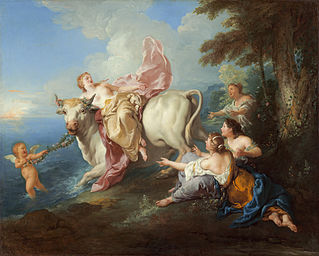Europa (mythology)
| Europa | |
|---|---|

Europa and the bull depicted by Jean-François de Troy (1716)
|
|
| Abode | Crete |
| Parents | Agenor and Telephassa or Phoenix and Perimede |
| Siblings | Cadmus, Cilix, Phoenix |
| Children | Minos, Rhadamanthys, Sarpedon/ Crete |
In Greek mythology Europa (/jʊˈroʊpə, jə-/; Greek: Εὐρώπη Eurṓpē) was the mother of King Minos of Crete, a woman with Phoenician origin of high lineage, and for whom the continent Europe was named. The story of her abduction by Zeus in the form of a white bull was a Cretan story; as classicist Károly Kerényi points out, "most of the love-stories concerning Zeus originated from more ancient tales describing his marriages with goddesses. This can especially be said of the story of Europa".
Europa's earliest literary reference is in the Iliad, which is commonly dated to the 8th century BC. Another early reference to her is in a fragment of the Hesiodic Catalogue of Women, discovered at Oxyrhynchus. The earliest vase-painting securely identifiable as Europa dates from mid-7th century BC.
Greek Εὐρώπη Eurṓpē contains the elements εὐρύς (eurus), "wide, broad" and ὤψ/ὠπ-/ὀπτ- (ōps/ōp-/opt-) "eye, face, countenance".Broad has been an epithet of Earth herself in the reconstructed Proto-Indo-European religion.
...
Wikipedia
